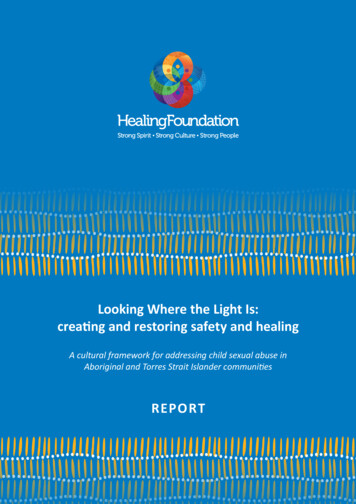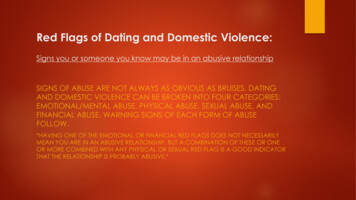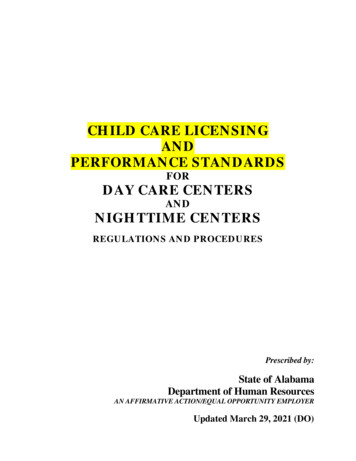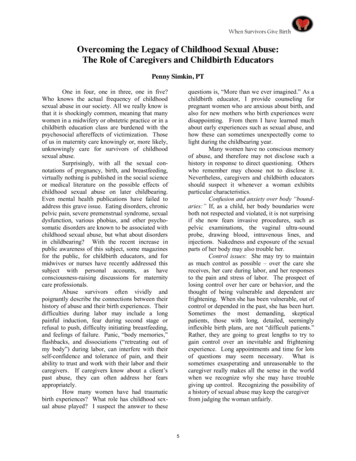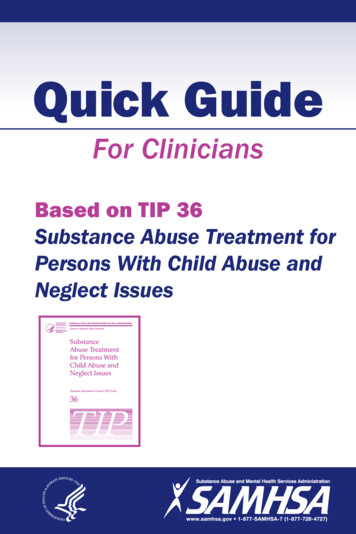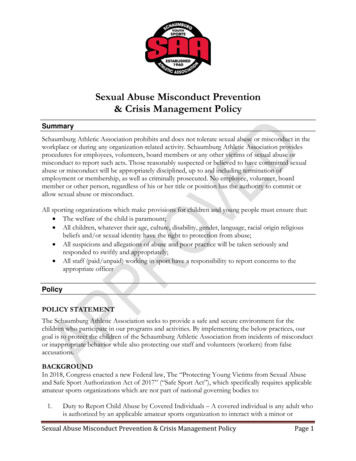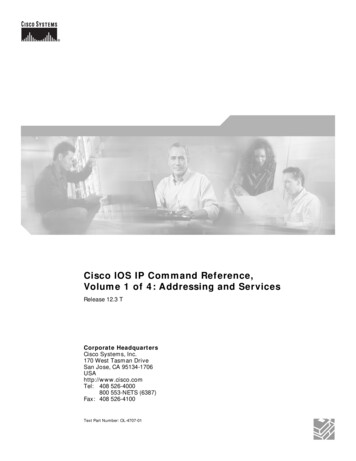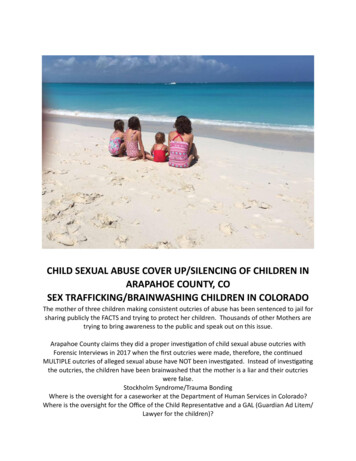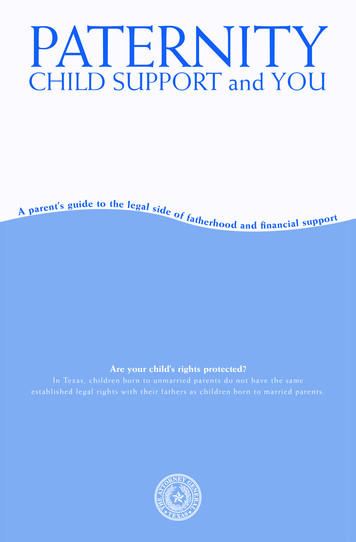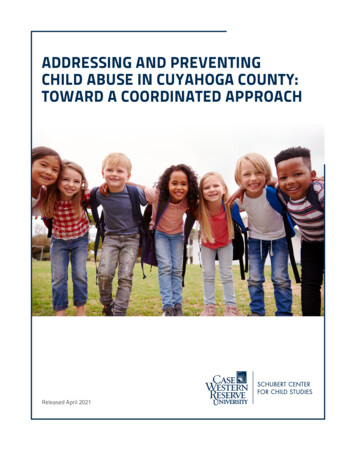
Transcription
ADDRESSING AND PREVENTINGCHILD ABUSE IN CUYAHOGA COUNTY:TOWARD A COORDINATED APPROACHReleased April 2021
ContentsExecutive Summary . . . . . . . . . . . . . . . . . . . . . . . . . . . . . . . . . . . . . . . . . . . . . . . . . . . . . . . 3Acknowledgments . . . . . . . . . . . . . . . . . . . . . . . . . . . . . . . . . . . . . . . . . . . . . . . . . . . . . . . . 4Introduction . . . . . . . . . . . . . . . . . . . . . . . . . . . . . . . . . . . . . . . . . . . . . . . . . . . . . . . . . . . . . . 5Our Challenge in Cuyahoga County . . . . . . . . . . . . . . . . . . . . . . . . . . . . . . . . . . . . . . . . . . 5The Urgency of Child Abuse and Neglect . . . . . . . . . . . . . . . . . . . . . . . . . . . . . . . . . 5Economic and Human Cost of Child Maltreatment and Neglect . . . . . . . . . . . . . 6The Current System of Child Abuse Investigation andResponse in Cuyahoga County . . . . . . . . . . . . . . . . . . . . . . . . . . . . . . . . . . . . . . . . . 6Child Fatality Case Studies . . . . . . . . . . . . . . . . . . . . . . . . . . . . . . . . . . . . . . . . . . . . . 6Community Efforts . . . . . . . . . . . . . . . . . . . . . . . . . . . . . . . . . . . . . . . . . . . . . . . . . . . 7Moving Towards a Solution . . . . . . . . . . . . . . . . . . . . . . . . . . . . . . . . . . . . . . . . . . . . 8An Opportunity for Impact: Coordinated Team-Based Models forAddressing Child Abuse . . . . . . . . . . . . . . . . . . . . . . . . . . . . . . . . . . . . . . . . . . . . . . . . . . . . 9Multidisciplinary Teams (MDTs) . . . . . . . . . . . . . . . . . . . . . . . . . . . . . . . . . . . . . . 10About the Child Advocacy Center . . . . . . . . . . . . . . . . . . . . . . . . . . . . . . . . 10Medical/Hospital-Based Child Protection Teams and Collaborations . . . . . . 12Best Practices for Early Identification and Harm Mitigation . . . . . . . . . . . . . . 14Barriers to an Effective System-Wide Coordinated Approach . . . . . . . . . . . . . . . . . 16Overcoming Barriers: Envisioning a Coordinated Medical CPT-MDTApproach in Cuyahoga County . . . . . . . . . . . . . . . . . . . . . . . . . . . . . . . . . . . . . . . . . . . 16Datasharing and Information Feedback Loops . . . . . . . . . . . . . . . . . . . . . . . . . . . . . . 17Current Canopy Operations . . . . . . . . . . . . . . . . . . . . . . . . . . . . . . . . . . . . . . . . . . . . . . . 18Funding . . . . . . . . . . . . . . . . . . . . . . . . . . . . . . . . . . . . . . . . . . . . . . . . . . . . . . . . . . . . . . . 19Conclusion . . . . . . . . . . . . . . . . . . . . . . . . . . . . . . . . . . . . . . . . . . . . . . . . . . . . . . . . . . . . . 20Appendices . . . . . . . . . . . . . . . . . . . . . . . . . . . . . . . . . . . . . . . . . . . . . . . . . . . . . . . . . . . . 22References . . . . . . . . . . . . . . . . . . . . . . . . . . . . . . . . . . . . . . . . . . . . . . . . . . . . . . . . . . . . . 262Addressing and Preventing Child Abuse in Cuyahoga County
Executive SummaryToo many children living in Cuyahoga County suffer from abuse or neglect. Even more alarming, the county’s rate ofconfirmed abuse or neglect-related child deaths is significantly higher than the national average. Black and Brownchildren are disproportionately victimized and represented in these rates. A suspected history of child abuse orneglect and/or domestic violence in the home are among the top risk factors for child homicides, and yet these riskfactors and other early warning signs are too often missed by providers. Additionally, there are reports of significantunderreporting of child abuse during the COVID-19 pandemic, which has heightened the sense of urgency to protectchildren. A more comprehensive, coordinated approach for early identification and treatment of child abuse andneglect is required.Cuyahoga County is uniquely resource-rich with three major hospital systems that come into contact with childvictims of abuse. The combined presence of MetroHealth, University Hospitals and the Cleveland Clinic, as well aslocal federally qualified health centers and community health centers, presents an opportunity to address childabuse in an impactful, county-wide strategy in partnership with the Cuyahoga County Division of Children andFamily Services (DCFS) and the existing child advocacy center (CAC). Cross-system collaboration with early warningmechanisms for child abuse detection and identification, improved referral, protection, and follow-up of cases,and coordinated information sharing across medical institutions and social service agencies would create a criticalnetwork to help prevent and reduce child abuse and neglect.This report presents findings of an investigation of best practices to reduce and prevent serious incidents of childabuse and neglect. Two well-established types of coordinated approaches to improving management of child abusecases were identified:(1) a multi-disciplinary team (MDT) that operates via a CAC(2) a medical child protection team (CPT)Multidisciplinary teams generally include representation from law enforcement, child protective services, prosecution,medical services, mental health services, social work, victim advocacy, and, if available, a CAC. The CAC-MDT modelthat involves a medical team has been shown to be effective at providing support, advocacy, and services to victimsand their families. Medical CPTs perform a number of essential tasks when working with victims of child abuseand neglect and their families, including medical consultations, communication of findings to appropriate agencies,multidisciplinary review of cases, forensic interviews, and expert testimony.Given the abundance of hospital resources and the availability of a functioning CAC in Cuyahoga County, one of arange of models could provide a much-needed county-wide coordinated response that engages all essential systempartners in a comprehensive child abuse prevention approach. Because of the complexity of individual cases, acomprehensive response requires a specialized coordinating approach. This coordinating approach may be achievedthrough various methods, including the highly effective use of CACs.This paper concludes with a proposal for Cuyahoga County, recognizing its unique attributes, resources and challenges:a medical CPT – comprised of clinicians from one or more of the three local hospital systems – to work closely with theMDT based at the CAC for early identification of child abuse and neglect cases and to provide a coordinated response,including effective treatment and ongoing support to victims and their families. A uniform protocol for interagencydata-sharing, a key component to a successful system-wide approach to aid in case conferencing and response, isnecessary so that data from all medical systems will be accessible to inform real-time decisions. Ideally, a database towhich all MDT and medical CPT members across hospitals have access will be developed to make client data availablefor informed decision-making, reduced duplication, and targeted service provision.Building this coordinated systems approach requires a committed public-private partnership with an initialinvestment of dedicated funding and resources for planning and implementation. While this may be a formidabletask, the payoff of helping to prevent child abuse and deaths in a racially equitable approach, while supportingvulnerable children and families in Cuyahoga County, makes this a worthy challenge.Case Western Reserve University // Schubert Center for Child Studies3
AcknowledgementsThis report was created in consultation with an interdisciplinary advisory group in response to a request from theDepartment of Child and Family Services (DCFS) Advisory Board. We thank them for identifying this as a concern forCuyahoga County and hope this will lead to a coordinated effort to improve our system of care for children across thecounty. We also thank leadership at DCFS under the direction of the Cuyahoga County Executive for their support ofthis report.This report would not have been possible without the committed support of the CPT Advisory Group. TheSchubert Center for Child Studies is grateful to the following individuals for their expert guidance and insightin shaping this paper:Tamara Chapman-Wagner, MPA: Cuyahoga County Division of Children and Family ServicesClaudia Coulton, PhD: Center on Urban Poverty and Community Development, Case Western Reserve UniversityDavid Crampton, PhD: Center on Urban Poverty and Development, Case Western Reserve UniversityRebekah Dorman, PhD: Invest in Children, Cuyahoga County Office of Early ChildhoodJoshua Friedman, MD, PhD: Cleveland Clinic Foundation, MetroHealthAndrew Garner, MD, PhD: University HospitalsJennifer Johnson, MSSA, LISW-S: Canopy Child Advocacy CenterJill Korbin, PhD: Schubert Center for Child Studies, Case Western Reserve UniversityJohn Ladd, MNO: Invest in Children, Cuyahoga County Office of Early ChildhoodLolita McDavid, MD, MPA: University Hospitals Rainbow Babies and Children’s HospitalAngela Newman-White, MA: Cuyahoga County Board of HealthKey AcronymsCAC: Child Advocacy CenterCFRB: Child Fatality Review BoardCPS: Child Protective ServicesCPT: Child Protection TeamDCFS: Cuyahoga County Division of Children and Family ServicesMDT: Multi-Disciplinary TeamThe Schubert Center for Child Studiesp: 216.368.0540 e: schubertcenter@case.edu w: case.edu/schubertcenterDirector: Anastasia Dimitropoulos, PhD Policy Director: Gabriella Celeste, JD Research Director: Sonia Minnes, PhDAdministrator: Lisa Kollins, MA Graduate Policy Research Assistants: Emily Miller, MSSA and Rebekah Russell, MPHThis project has been generously supported by JoAnn & Robert Glick.4Addressing and Preventing Child Abuse in Cuyahoga County
INTRODUCTION: PURPOSE OF THIS REPORTThis report describes the current landscape of child abuse and neglect in Cuyahoga County and the currentsystem for addressing child abuse cases, as well as other models for a coordinated response and prevention ofrevictimization. The following review is informed by academic literature, research reports and interviews with keystakeholders: pediatricians, physicians, directors and staff of child advocacy centers from around the nation, as wellas an advisory group of local experts who work in child welfare, pediatrics, advocacy, and research. It is intended tooffer information that will advance an effort toward a county-wide, coordinated model for addressing child abusethat involves close collaboration among a team of medical practitioners (i.e., a medical CPT), a multidisciplinary teamof key stakeholders (MDT), and a coordinating entity (i.e., typically the function of a CAC).Our Challenge in Cuyahoga County: Current Social Problem of Child Abuse and Neglectand Uncoordinated System ResponseTHE URGENCY OF CHILD ABUSE AND NEGLECTIn 2018, almost 200,000 referrals were made to child welfare agencies across Ohio, and over 25,000 childrenwere found to be victims of abuse and neglect. Examining the child abuse and neglect data for Cuyahoga Countyilluminates the critical need to improve the process of identification, response and prevention of harm. In 2018, therewere 257,827 children in Cuyahoga County. That year, the Cuyahoga County Division of Children and Family Services(DCFS) received 21,557 referrals for child abuse and neglecta, up from 20,429 in 2017 and 20,438 in 2016. The numberof referrals screened in for child abuse or neglect was 14,036 in 2018. Total referrals investigated were 15,570(includes dependency and family in need of services) of 24,220 calls. Table A illustrates the types of abuse and thecorresponding number of children who were victims of each type in 2018.TABLE A. CUYAHOGA COUNTY CHILD ABUSE & NEGLECT, 20182Key Child Abuse and Neglect Statistics, 2018Total Investigations14,036TypeDistinct Counts of Children bSubstantiated physical abuse1,699Substantiated neglect1,283Substantiated sexual abuse227Emotional maltreatment80Medical neglect52Abuse or neglect-related child deaths8In Cuyahoga County, there were a total of 185 total child deaths in 2018 and 174 child deaths in 2019. Of thesedeaths, a disproportionate amount were Black children – 120 in 2018 (approx. 65%) and 115 (approx. 66%) in 2019. In2018, there were 11 homicide deaths among children; child suspected history of abuse/neglect or domestic violenceabDoes not include dependency or families in need of service referrals.Each child is only counted once. Children may have multiple referrals and multiple findings.Case Western Reserve University // Schubert Center for Child Studies5
in the home remained top risk factors associated with child homicide. In addition, in 2018, 29 of the 185 children diedas a result of unintentional injuries, with 18 of these cases having suspected history of abuse, neglect, or domesticviolence in the home.3 In 2019, there were 27 unintentional injury deaths.3 In that same year, 4 children died due toabuse and 5 children died due to neglect, compared to 5 abuse and 3 neglect deaths in 2018. The rate of confirmedabuse or neglect-related child deaths in 2018 was 3.0 per 100,000 children, much higher than the national rate of2.39 per 100,000 children in 2018. In Cuyahoga County, the rate of child death has been consistently higher thanthe rest of the state for over a decade. The COVID pandemic has made this issue even more urgent with significantconcerns of the underreporting of child abuse during this time period.4Economic and Human Cost of Child Maltreatment and NeglectThe cumulative effects of trauma, poor mental and physical health outcomes, educational setbacks, and otherchallenges due to child maltreatment can have lifelong consequences for child victims of abuse and neglect. Theeconomic impacts, in addition to the human and societal costs, are also significant. A study by the Centers for DiseaseControl and Prevention (CDC) found that the total cost resulting from nonfatal and fatal maltreatment in the UnitedStates was estimated at 585 billion (2008 USD).5 This same study revealed that the average cost per victim ofnonfatal child maltreatment over their lifetime involved a range of different types of costs. These include: childhoodhealth care costs ( 32,648), child welfare costs ( 7,728), criminal justice costs ( 6,747), special education costs ( 7,999),and adult medical costs ( 10,530), totaling 210,012 in 2010 USD.5 Another more recent study found that the economicburden of child maltreatment was as high as 2.0 trillion (2015 USD). In terms of cost per child, research has foundthat the lifetime cost for nonfatal child maltreatment was 831,000 per child, and the lifetime cost for fatal childmaltreatment was 16.6 million per child, which includes the value of victims’ lost work productivity (2015 USD).6The Current System of Child Abuse Investigation and Response in Cuyahoga CountyIn Cuyahoga County, child abuse and neglect cases are referred to the DCFS from various sources – family, neighborsand Ohio’s mandated reporters, who include but are not limited to: attorneys, child care workers, foster parents,nurses, physicians, hospital interns and residents, psychiatrists, school authorities and staff, and social workers.7Generally, the following process occurs: Screening: A referral is made to the DCFS hotline by phone, email, letter, Facebook Messenger, or as a walk-in.The hotline staff determines whether the report requires an emergency or non-emergency response, which isreviewed by Child Protection Specialists. Referral: Cases involving sex abuse of a child 12 years or young or children of any age who are victims of humantrafficking meet the criteria for referral to the Canopy Child Advocacy Center in Cleveland (Canopy). Canopycoordinates comprehensive services for the client through their Multidisciplinary Team from referral to caseresolution. DCFS handles all other child abuse and neglect cases from referral to case resolution. Investigation: Currently, there is limited collaboration between the coordinating agency (Canopy or DCFS) anda hospital system. Typically, a hospital will refer a client to DCFS and allow DCFS to “take it from there”, or ahospital will be engaged as needed by Canopy or DCFS to provide services for a client.See Appendix 1 for a flow chart of the general process for child abuse referrals to DCFS and Canopy.Child Fatality Case StudiesThe Cuyahoga County Office of Early Childhood undertook a review of 2018’s Child Fatality Review Board (CFRB) casesand identified the following real-life examples to better illustrate gaps in the child welfare context. The followingthree child case studies highlight medical negligence and are intended to help others understand the types of caseswhere a medical CPT as part of a coordinated multi-system approach could have resulted in a different outcome. The6Addressing and Preventing Child Abuse in Cuyahoga County
CHILD ABUSE SCENARIO (PART 1) – THE INITIAL REFERRALThis scenario, presented as a 7-part hypothetical case throughout this report, illustrates an alternativeresponse to our current approach. It is a fictional, but realistic, representation of how a child abuse orneglect case may play out in Cuyahoga County if there is a coordinated response model with a medical childprotection team (CPT) and multidisciplinary team (MDT).A call is made by a neighbor into children’s services and relays the following information:Johnny (age 7) was playing with a neighbor when his shirt lifted and revealed what appeared to be ahandprint and scratches on his back. Johnny told his friend he was often hit by his dad with his handand belt because he is a ‘bad boy who can’t listen.’ Still, Johnny did not seem scared to go home.The Division of Children and Family Services (DCFS) opens the case and visits Johnny’s mother the next day toassess safety and possible next steps. His mother discloses that she is aware that Johnny gets hit with thebelt. She says the last time he saw his dad was yesterday while she was at work, before he played with theneighbor’s son. Since Johnny bathes himself, she hasn’t seen any marks and says she does not believe he hasmarks.The caseworker does a child-focused interview and affirms the information provided by the referent. Thecaseworker has Johnny raise some of his clothing, sights bruising, and becomes increasingly concerned forserious physical abuse. There are bruises with patterns, in clusters and in multiple colors, sizes, shapes, andvisible locations. After a consult with the DCFS supervisor, it is determined that these injuries and the threatof further harm to Johnny are serious.names and other identifying information have been removed to protect the confidentiality of the families. These caseexamples contain only actual facts surrounding actual deaths without additional editorial comment. See Appendix 2for the full case examples. Case Example 1: Child under 10 years old known to the child protective services system with history of asthma.Official cause of death was asthma, although there was circumstantial evidence of medical neglect. Case Example 2: Child under four years old hospitalized for much of the first year of their life due to congenitalanomalies. Cause of death was blunt force trauma due to homicide. Case Example 3: Five-month-old child who was born two weeks late and as an infant had several missedpediatric appointments. The cause of death was failure to thrive with severe malnutrition and dehydration.Community EffortsAcross the county, many community-based agencies and organizations offer invaluable services: residential andday treatment, emergency shelter, alternative school programs, trauma-informed therapy, child and family-focusedtherapy, and other mental health treatment. Of specific interest for this report, DCFS and local hospitals haveimplemented innovative, supplemental approaches to help address the critical needs related to child abuse andneglect in Cuyahoga County. In addition to the Child Advocacy Center model discussed later in this report, examplesof local initiatives include the programs below.ccThe current report focuses on coordination among three hospital systems in Cuyahoga County: Cleveland Clinic, MetroHealth, and UniversityHospitals. It should be noted that there are a number of other institutions and entities in the County, including community clinics, that servechildren and their families that also present opportunities for a more comprehensive coordinated effort.Case Western Reserve University // Schubert Center for Child Studies7
HOSPITAL-BASED CHILD ABUSE PROGRAMS The Child Advocacy and Protection Program at University Hospitals: This program utilizes a team approachthat includes a physician, a nurse practitioner, and a social worker who specializes in child abuse. The teamprovides medical and psychosocial assessment services to suspected child victims of physical and/or sexualabuse. In addition, the Child Advocacy and Protection team consults with school systems, insurance groupsand Medicaid, and government agencies to advocate for improvement of these systems to better identify andaddress child abuse. MetroHealth Alpha Program: The Alpha Clinic program serves children who may be victims of sexual abuse byproviding medical assessments by an experienced pediatrician, nurse, child life specialist and social worker. TheAlpha Team at the Clinic provides inpatient evaluation and consultation when there is concern for child abuseand neglect. Cleveland Clinic Foundation Child Protection Team: The Cleveland Clinic Foundation CCF) CPT is a committeethat meets regularly to review medical cases and hospital policies. The Cleveland Clinic health system has achild abuse and neglect policy that guides the assessment and management of child patients who are victimsof physical, sexual or medical abuse. The CCF CPT pediatrician and an inpatient social worker provide inpatientevaluation and consultation when there is concern for child abuse and neglect.OTHER VIOLENCE PREVENTION AND INTERVENTION PROGRAMS START (Sobriety Treatment and Recovery Teams) and Ohio START (Sobriety, Treatment and Reducing Trauma):These child welfare programs support families where parents have substance use disorders by providingintensive case management, behavioral health services, and family peer mentors. In Cuyahoga County, STARTlinks families to services that support children and their families in order to overcome addiction, prevent childmaltreatment and stabilize families. Hospital-based Violence Prevention Initiatives: While not explicitly designed to address child abuse orprevent child abuse, the following hospital-based initiatives are valuable parts of the community response tointervening and preventing community violence.– The Antifragility Initiative at Rainbow Babies and Children’s Pediatric Trauma Center: This program servespediatric victims of violence and aims to reduce violent injury recidivism using trauma-informed careprinciples from bedside engagement. This effort is in collaboration with the Center on Urban Poverty andCommunity Development at the CWRU Jack, Joseph & Morton Mandel School of Applied Social Sciences,Cleveland Peacemakers Alliance, and Frontline Services.– Violence Interrupters at MetroHealth Medical Center: The program serves all victims of violence in theMetroHealth emergency department and provides conflict resolution, case management, and links to supportthrough outreach workers. This is a partnership among the Northern Ohio Trauma System, MetroHealthMedical Center and the Cleveland Peacemakers Alliance.Although these initiatives are important community collaborations, they are isolated within the three major hospitalsystems in Cuyahoga County – MetroHealth, University Hospitals, and Cleveland Clinic – and service agencies. Eachof these initiatives provide important care and services to youth; however, they do not share information or formallycollaborate. Strengthening county-wide coordination among our major hospital systems, in partnership with DCFS,rather than relying on the existing patchwork of responses, would foster a more protective community response andreduce the danger of abuse victims and at-risk children falling through the cracks.Moving Toward a SolutionChild maltreatment is clearly a pressing issue in Cuyahoga County. Numbers of child deaths are alarmingly high, withmany of these child deaths being suspected – but not confirmed – child abuse or neglect cases. This suggests that8Addressing and Preventing Child Abuse in Cuyahoga County
CHILD ABUSE SCENARIO (PART 2): THE MEDICAL CPT RESPONSEWith the CFS Supervisor’s backing, the caseworker calls in a ‘Health Alert’ referral to the child protectionteam (CPT). The CPT care management nurse investigates and, with assistance from the CPT social workand pediatric medical providers, determines that it is best to bring Johnny to the CAC for a Nurse ExaminerSpecialist Safety Triage (NESST), rather than to the emergency room. The CFS supervisor, case worker, clinicalpsychologist, advocate, forensic interviewer and law enforcement staffing the CAC are consulted on thisrecommendation and concur. The case worker helps coordinate transportation for an immediate appointment.When Johnny and his mother arrive, the CAC advocate brings them to the healing room for introductions.An explanation of the medical examination process, a tour of the examination suite and an opportunity forquestions are provided. Johnny and his mother then settle into the healing room while the nurse practitioner,forensic nurse, and case worker have a private discussion elsewhere regarding the CFS’s concerns and thefamily history (e.g., previous CFS reports for abuse and neglect).early warning signs of maltreatment may have been missed, and better early warning systems for detection andidentification, as well as improved referral, protection, and follow-up of these cases could save lives. In order to betteraddress the issue of child abuse and neglect in Cuyahoga County, cross-system coordination and alignment may benecessary. The Cuyahoga County Child Fatality Review Board (CFRB) recommends that collaboration and informationsharing among medical institutions and social service agencies be developed as a county-wide, systems-coordinatedresponse, which will lead to enhanced intervention for children who are at high risk. Despite great efforts to addressthe issues outlined above, the general system of care for victims of child abuse remains disconnected. In CuyahogaCounty, while a few specialized programs exist, they are focused on select populations or select issues and, in mostcases, do not coordinate resources among the major hospital systems in the area. A more effective endeavor willrequire an evidence-informed approach facilitated by county-wide institutional efforts that bring together differentstakeholder expertise to support victims and their families, from medical treatment to emotional support and legalsystem support and advocacy. The combined presence of MetroHealth, University Hospitals and the Cleveland Clinicpresents an opportunity to address the issue of child abuse in an impactful, county-wide way, in partnership withother community organizations and agencies.AN OPPORTUNITY FOR IMPACT: COORDINATEDTEAM-BASED MODELS FOR ADDRESSING CHILD ABUSEThere are two well-established types of coordinated approaches to addressing child abuse cases: multi-disciplinaryteams (MDTs) that operate via a child advocacy center (CAC)d and medical or hospital-based child protection teams(CPTs). Historically, multidisciplinary approaches to addressing child abuse have been established in a range of ways,varying by state.e In 1986, the Children’s Justice and Assistance Act was adopted with the aim of providing federalfunding to assist states in developing, establishing, and operating programs designed to improve the handling ofdeThe Child Advocacy Center (CAC) approach to MDTs was first realized in the mid-1980s when Alabama Congressman Robert Cramer convenedlaw enforcement, criminal justice representatives, child protective services, and medical and mental health workers to establish onecoordinated team (National Children’s Alliance, 2019).As early as 1970, Montana passed legislation suggesting the need to establish child protection teams (Jacobson, 2002). Pennsylvania (PA CodeTitle 23, chapter 63), Florida (FL Code Title V, chapter 39, 39.303) and Oregon (ORS 418.747) are among some of the states that have mandatedthat a multidisciplinary team be established in each county and that members of the team share complete child abuse case information withone another. The state provides funding; federal support is also available via the Child Abuse Prevention and Treatment Act and the Children’sJustice and Assistance Act of 1986 for locations with mandated MDTs.Case Western Reserve University // Schubert Center for Child Studies9
child abuse cases. The focus was on limiting additional trauma to the child and improving responses, specifi
as a result of unintentional injuries, with 18 of these cases having suspected history of abuse, neglect, or domestic violence in the home .3 In 2019, there were 27 unintentional injury deaths .3 In that same year, 4 children died due to abuse and 5 children died due to neglect, compared to 5 abuse and 3 neglect deaths in 2018 .The rate of .
